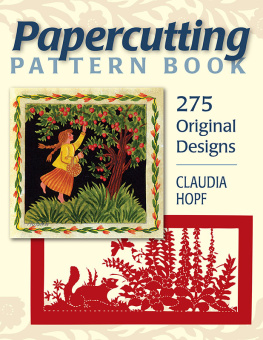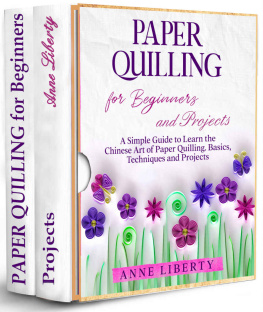
THE ART OF PAPER CUTTING
BEVERLY MASSACHUSETTS
QUARRY BOOKS
HENYA MELICHSON
Contents
Introduction
I ARRIVED AT THE ART OF PAPER CUTTING quite by chance, after having drawn, sketched, and painted for several years. After completing a few paper cuts, I became enchanted with the medium, as I realized that the skills I had been honing with pencils and paint could be expressed through paper cutting.
From that moment onward, I have been channeling my artistic efforts into paper cutting. With this book, I hope to convey that enthusiasm to you, and inspire you to find the same delight in this precise, ancient, and beautiful art.
The Art of Paper Cutting features a selection of paper cuts that I made over the course of several years, reflecting diverse influences in my life. In addition to calling upon styles and symbols traditionally used in paper cutting, I have also integrated artistic techniques usually associated with drawing to create works with depth and movement.
Some of the paper cuts communicate specific messages; others are simply aesthetic, designed for the purpose of expressing beauty. All of them have been done out of inspiration, love of the craft, and a belief that any imagined image can be created through paper cutting.

OPPOSITE, PARROT STAINED GLASS, BLACK PAPER WITH WHITE BACKING, 24" 10" (61 25 CM)
PAPER CUTTING AROUND THE WORLD
Paper cutting is an ancient craft that is practiced in diverse forms in cultures around the world. In some cultures, only white and black papers are used; in others, colored papers and paints are favored. In some cultures, paper cuts are done only with scissors; in other cultures, sharp blades are used. In some cultures, the paper is folded once, twice, or several times before cutting; in other cultures, the paper is never folded.
Despite these differences, there are also many similarities. For example, paper cutting is generally connected to other arts, and may borrow ideas and patterns from other areas. In ancient China, paper cuts were used to transfer embroidery patterns, and for adding decorations to ceramics. Wood carvings had an impact on paper cutting in England, France, and Holland, while the patterns featured in Persian carpets inspired paper cutting for book covers in ancient Iran and Iraq. At the same time, diverse art forms have also been influenced by paper cutting. Lace patterns have been influenced by paper cut designs in Europe, the United States, and Mexico.
Asia
Paper cutting likely originated in China, the country where paper was invented. It is known here as jian zhi, and was traditionally used to transfer patterns, adorn walls and windows, and decorate presents. Chinese paper cuts are often cut from red paper; common motifs include flowers and animals.
In Japan, paper cutting is known as kirigami. A cousin of the widely known craft of origami (the art of paper folding), kirigami combines both folding and cutting. In ancient times, kirigami was used to cut the symbols of great Samurai families. Paper cut stencils were used to transfer these symbols to peoples clothing and property.
Shadow puppetry is an Asian craft based on paper cutting. In these plays, puppets are cut from paper using sharp knives, and shows are carried out in front of an illuminated surface. These plays likely originated in China, but eventually spread throughout Asia, and are popular today in Thailand and India.
The Americas
The United States, as a center of immigrants, attracted people from all over Europe, and when they came, they brought with them distinct paper cutting traditions. Paper cuts were used for diverse purposes, including decorating religious texts, public documents, and cards. Traditional U.S paper cuts may depict homestead scenes or images associated with holidays. Paper cuts are particularly favored on Valentines Day, when people often send frilly heart-shaped cards to their loved ones.
Mexico features a distinct form of paper cutting known as paper picado or punched paper. In this technique, artists use a hammer and chisel to punch designs onto stacks of thin colored paper. They may produce tens or hundreds of paper cuts at one time. The paper cuts are often cut into long banners, and used for decorations during Day of the Dead celebrations, and other holidays.
Europe
Paper cutting arrived in Europe during the fifteenth century, and was quickly embraced by craftspeople in several countries. Known as scherenschnitte in German, the craft became very popular in both Germany and Switzerland by the 1600s. It was used to cut stencils for furniture, embroidery, and lace patterns. One style that was particularly popular in these cultures was using paper cuts to decorate the front of greeting cards, while the inside featured a religious sign or the image of a saint. Another popular style, known as marques, involved cutting very delicate bookmarks. Paper cuts here are usually made with a blade, and the paper is not folded. Common motifs include mountain images, vases with flowers, rural scenes, and portraits.
In England, paper cutting became a pastime for people in the upper classes during the nineteenth century, alongside embroidery and other handicrafts. Silhouettes were a popular form of paper cutting all over Europe during the eighteenth and nineteenth centuries. They are an excellent method for reproducing the likeness of a person or place without using a camera.
In Holland, paper cutting is known as papiersnyden. It is traditionally done on white paper, without any addition of color. Dutch paper cuts are almost always cut with scissors, and though they may be either symmetrical or asymmetrical, the paper is almost always unfolded. One distinct Dutch style of paper cutting involves cutting small serrated scales.
In Poland, paper cutting is known as wycinanki, and dates to the nineteenth century. Polish paper cuts generally involve various colors of paper, often affixed in layers. These papers are cut, clipped, or torn, then assembled into a composite image. Peacocks, flowers, roosters, and star-shaped medallions are common motifs.

TRADITIONAL DUTCH PAPER CUT, RED PAPER ON WHITE BACKGROUND, 6" 4" (15 10 CM)

TRADITIONAL POLISH PAPER CUT, BLACK PAPER WITH LAYERS OF COLORED PAPER ON WHITE BACKGROUND, 6" (15 CM) DIAMETER
Types of Paper Cuts
BOOKMARKS
Paper cuts can be used to fill a variety of functions, both practical and aesthetic. In the following pages, you will see examples of my favorite types of paper cuts, and get ideas on how you can put your own paper cuts to use.
If you are just starting out in paper cutting, bookmarks are excellent first projects. They are relatively small, which means you can likely complete one in just a few hours. Bookmarks arent only for beginners, though, and you can integrate any type of design you like, be it simple, intricate, or something in between. Insert a piece of colored paper into a folded paper cut to add a colorful background to your design. Both functional and aesthetic, bookmarks make lovely gifts.
Next page











